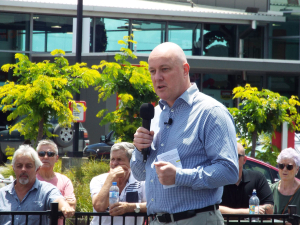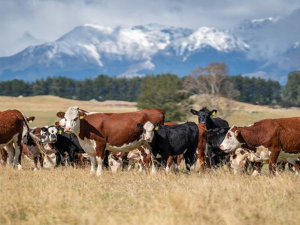Falling interest rates, combined with a rising forecast milk price, mean this season’s looking a lot better than the previous one, says Federated Farmers dairy section chair Richard McIntyre.
McIntyre says farmers expect banks to pass the official cash rate (OCR) cuts onto farmers. Last week the Reserve Bank cut the OCR by 50 basis points to 4.75%. Further cuts are expected in the coming months.
McIntyre says while farmers welcome the cuts, they want the focus on “the systemic issues affecting interest rates”.
“Falling interest rates will be welcome news for farmers, and when you combine them with a rising milk price, this season will almost certainly look a lot better financially than the last,” he told Dairy News.
“That being said, Federated Farmers are more focused on the systemic issues affecting interest rates. Interest rates rise and fall in cycles, but if we can get the settings right, farmers will consistently pay lower interest rates and get better service no matter where we are in that cycle.”
The lower interest rates and a near-record milk price this season are also expected to boost farmer spend this season. ANZ last week became the latest bank to lift its forecast farmgate milk price to $9/ kgMS, matching Fonterra’s midpoint.
ANZ agriculture economist Susan Kilsby says a $9 milk price would allow many farmers to spend on the repairs, maintenance and fertiliser that many cut back on last season.
Read More
“We also expect the higher returns to result in an increase in principal debt repayments,” she says.
ANZ is predicting another 50bp cut to the OCR next month.
Kilsby notes that the market is confident of a series of rapid drops in the OCR and that has fed through into lower rates across the yield curve.
“This, in turn, has resulted in lower fixed mortgage rates on offer to businesses and individuals.”
However, farmers are not convinced that they’re getting a good deal from the banks.
Last week Federated Farmers made its submission to Parliament’s banking inquiry: it included more than 1500 comments from farmers fed up with paying over the odds for banking services.
“Lack of competition in rural banking, unfair practices, unjustifiably high interest margins and overly cautious Reserve Bank restrictions are seriously disadvantaging the nation’s food producers and export income earners,” McIntyre says.
Federated Farmers believes farmers are currently paying up to 1.7% more in borrowing costs than they should in a fair and open market.
“We’re calling for urgent banking reform in the agricultural sector, where $62.5 billion in lending means even a 1% difference in margins represents $625 million,” McIntyre says.
One of Federated Farmers’ key recommendations is for the Government to revise the Reserve Bank’s stringent one-in-200-year financial shock standard, which significantly raises borrowing costs for farmers.
Moving to a one-in-100-year standard would still ensure stability while lowering costs for rural borrowers, McIntyre says.
More than one in five Kiwi farmers say their bank isn’t allowing them to structure their debt to minimise interest payments as much as possible.
Too many farmers say they are pressured to use overdrafts to manage debt repayments or fund capital projects – tasks overdrafts were never intended for.
In fact, 12% of farmers say their bank has asked them to fund capital work using an overdraft.
“This is unacceptable,” McIntyre says.
“Overdrafts are designed for managing seasonal cash flow, not to burden farmers with higher-interest debt to boost bank profits.”


















